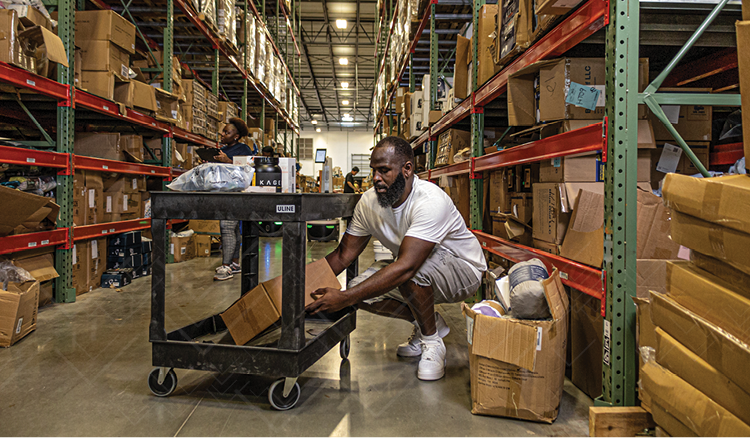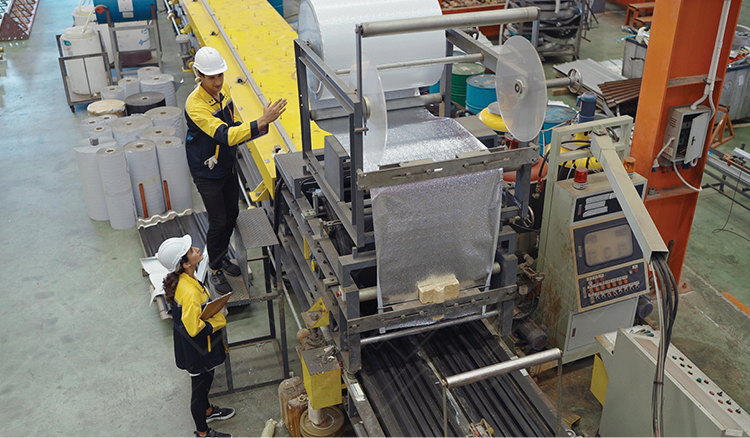How On-Demand Labor Helps You Navigate the Pre-Peak Period Without Overcommitting
Every operations leader knows the Q4 peak season can make or break the year, but the truth is, margins are often won or lost before the true rush even starts. In the weeks leading up to peak, inbound inventory surges, promotions launch, and special projects like labeling or kitting pile up. This “pre-peak” window is where many logistics, consumer products, and packaging companies fall into the trap of hiring too soon, carrying idle labor, and watching margins slip away before demand even hits. The solution? A more flexible approach to labor that scales only when and where it’s needed.
The Pre-Peak Dilemma
Inbound inventory starts landing, promotional orders come in waves, and value-added work like kitting, labeling, and staging ramps up.
The challenge: demand for these task fluctuates widely from day to day. Yet traditional hiring models push companies to add seasonal headcount weeks before demand truly arrives. That premature overstaffing destroys margins before peak even begins.
- Idle hours burn cash: 20 workers with two idle hours per shift = 200 paid hours wasted every week.
- Margins vanish: Even small amounts of wasted labor can quickly erode profitability and put seasonal margins at risk.
- Forecasts shift: Retailer delays or promotional changes often leave companies overstaffed with no work to absorb the cost.
In short: if you’re too heavy pre-peak, you enter peak already behind on profitability.
The Pre-Peak Work Mix
Pre-peak isn’t about brute force—it’s about precision, timing, and flexibility. Unlike peak season, where outbound order volume dominates, the pre-peak window is shaped by variable, project-based workflows that don’t run at a steady pace.
Receiving & Dock-to-Stock
Inbound shipments often arrive in unpredictable waves, creating sudden spikes in workload followed by lulls. Moving inventory quickly from dock to stock is critical to prevent downstream bottlenecks that could cripple peak performance. If product sits on the dock for days, your outbound team will be fighting uphill during peak.
Labeling & Kitting
Retail promotions and holiday bundles add complexity in pre-peak. Building promotional SKUs, applying special labeling, or assembling retail-ready kits can’t always be scheduled neatly into existing workflows. These projects often arrive suddenly and require dedicated focus—but tying up your core team risks slowing down daily operations.
Staging Outbound Loads
Retailers expect shipments to flow seamlessly once peak begins. That means pallets must be prepped, staged, and ready for distribution. But staging isn’t a steady process, it depends on order timing, trailer availability, and customer deadlines. With a fixed workforce, you’re often left choosing between paying for idle hands or relying on costly overtime.
The Challenge
These workflows spike and stall based on inbound schedules, promotional timing, and customer requirements. Maintaining a bloated fixed headcount to cover every possibility creates idle hours, wasted payroll, and margin erosion before peak even arrives.
How On-Demand Labor Solves the Pre-Peak Problem
Traditional staffing forces companies to hire weeks in advance, creating idle labor, wasted payroll, and margin erosion.
Veryable solves this through the concept of an on-demand labor pool. Think of it like a sideline bench of trained workers who can be deployed exactly when and where they’re needed. Instead of committing to extra staff weeks before pre-peak, you deploy workers only for the hours or days you need, ensuring you’re only paying for the work performed.
Here’s how the labor pool works in pre-peak:
- Receiving: Tap into your labor pool to handle surges of inbound inventory and accelerate cycle times without overburdening your core team.
- Labeling & Kitting Projects: Deploy operators from your labor pool for promotional builds or retail-ready bundles exactly when needed, then scale back once complete.
- Outbound Staging: Deploy on-demand operators to prep pallets for upcoming shipments, ensuring deadlines are met without paying for idle hands or overtime.
In short, an on-demand labor pool lets you turn pre-peak from a margin risk into a strategic advantage. You maintain flexibility, reduce wasted payroll, and keep workflows moving smoothly.
“We might see one week where we do need an additional capacity to kit. So we add in operators for that. And then also we have some other projects where we might just need to be labeling something so we can bring in operators for just that specific project. And then after the project's over with, we don't have to hang on to that additional labor.”
-Wilson Duke, Warehouse Director, Made in Cookware
Peak & Post-Peak: Flex Your Workforce, Protect Your Margins
Peak Period: Sustain Throughput and Avoid Bottlenecks
During the height of peak season, order volumes can spike unpredictably, putting pressure on picking, packing, staging, and loading/unloading workflows. With a labor pool, you can scale capacity in real-time, deploying trained operators exactly where they are most needed.
This helps you:
- Break bottlenecks instantly: Deploy labor to slow-moving workflows to maintain throughput.
- Address demand spikes: Deploy operators to different shifts and work areas as daily needs change.
- Reduce errors and fatigue: Avoid overloading your core staff with overtime, keeping accuracy high.
"We've had some situations where the same day we realize that, oh, we come in on a Monday and we have three thousand more orders than what we were expecting. And so by ten o'clock, we can have another group of of people coming in."
-Jared Murphy, Innovation Engineer, RTIC Outdoors
Post-Peak: Scale Down Strategically
After peak, when outbound volume declines and returns rise, traditional seasonal staffing leaves facilities overstaffed or forces abrupt layoffs. Veryable on the other hand, enables companies to scale down labor efficiently while retaining support for essential tasks.
- Right-size the workforce: Reduce on-demand operator usage accordingly as outbound volume decreases.
- Maintain critical support: Deploy operators as needed for returns, restocking, and reconciliation tasks.
- Protect margins and morale: Avoid idle labor costs and abrupt layoffs that impact team morale.
- Protect your investment: The operators you’ve trained and relied on aren’t lost, they can be redeployed the next time demand spikes, giving your operation a massive operational competitive advantage.
The worst part of my job is laying somebody off... It happens every year with our business. It just kinda takes a downturn at the first of the year right after holidays, and we expect about 30% of our workforce to be laid off. That didn't happen this year. And it's because with Veryable, I'm able to scale up and go crazy bonkers when I need to, but I'm also able to pull back. Maybe I don't book out as much Veryable for the next thirty days but they're available. They're there.
-JaNiece Cranmer, President, Scentsational Soaps & Candles
Real World Example - Arbonne International
Arbonne International’s Greenwood, IN facility operates in a fast-paced environment, fulfilling thousands of orders daily for health and beauty products. Like many distribution centers, the facility faces significant fluctuations in demand, particularly around seasonal peaks like Black Friday, where order volumes can spike dramatically in just a few days. Historically, the facility struggled with overstaffing during the pre-peak period, which drove unnecessary labor costs and low engagement, and understaffing during peak periods, which led to overtime, delays, and core team burnout.
To address this, Arbonne built an on-demand labor pool skilled in picking, packing, kitting, pallet jack operation, and housekeeping that can deployed as needed across 1st & 2nd shifts to mirror actual real-time demand.

The Results:
✅ $36K saved by preventing early overstaffing.
✅ $18K saved by eliminating overtime during the Black Friday rush.
Note: These savings do not even account for additional benefits such as improved worker performance, lower hiring costs, or potential revenue growth.
On-Demand Labor: Your Competitive Edge Throughout Pre, Peak, and Post-Season
Pre-peak is where seasonal margins are made or broken. By building an on-demand labor pool, companies can avoid the pitfalls of early overstaffing, accelerate critical workflows, and enter peak season lean, agile, and profitable. The flexibility continues through peak and post-peak periods, keeping throughput high, service world class, and costs under control.
Ready to stop overcommitting to a fixed headcount? Connect with our team today and learn how you can make the most of your peak season.
To Learn More About How On-Demand Labor Can Help You Maximize Q4 Peak Season Performance, check out these articles:
- Capitalizing on Q4 Opportunities: How Forward-Thinking Business Leaders Are Scaling Smarter
- Outperform When It Counts: How Ops Leaders Are Owning Peak Season With On-Demand Labor
- How 3PLs Can Crush Peak Season KPIs Without Overstaffing or Overtime
- The Key to Q4 Peak Season Success in Consumer Products - Labor Flexibility
- Scaling For Peak Season: Why On-Demand Labor is a Game-Changer for E-Commerce, Logistics, and Packaging
Previous Posts
How Policy Constraints, Not Just Production Bottlenecks, Threaten Your Bottom Line
The Future of Manufacturing and Logistics
Create a free business profile today to explore our platform.






